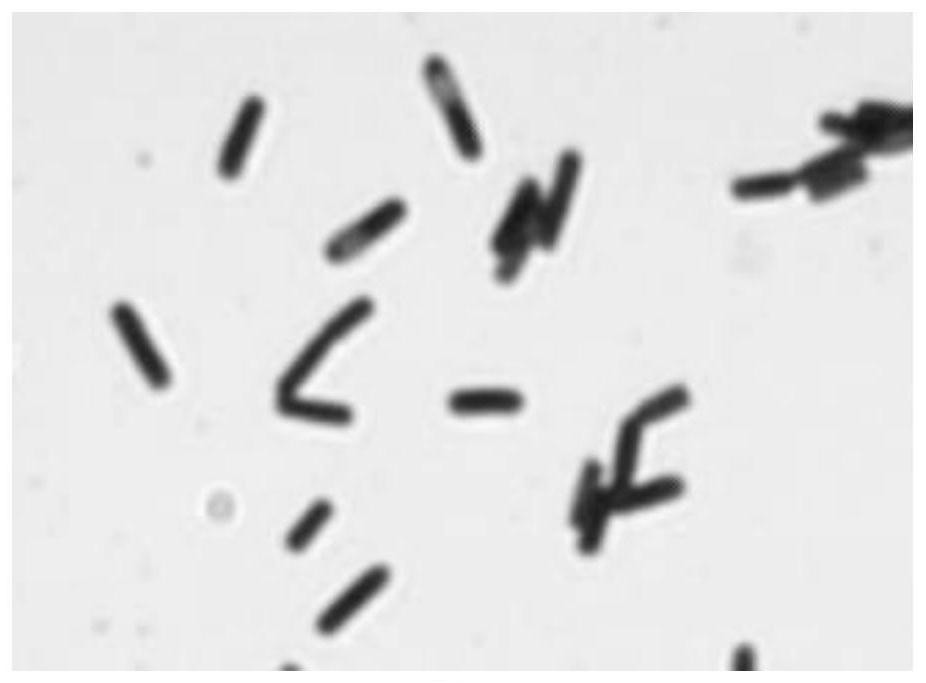Hainella bacillus ly-23, bacteria agent and its application and products using it
A technology of Bacillus bacillus and LY-23, applied in the field of microorganisms, can solve the problems that the industrial production potential has not been fully utilized, donkeys are prone to digestive system diseases, and the source of core bacteria is unclear, so as to reduce the risk of digestive system diseases Chance, Immunity Boost, Good Enzyme Activity Effects
- Summary
- Abstract
- Description
- Claims
- Application Information
AI Technical Summary
Problems solved by technology
Method used
Image
Examples
Embodiment 1
[0056] Isolation, purification and biochemical characteristics of Bacillus haynesii from donkey:
[0057] (I) Medium for separation: beef extract peptone medium, the medium components are as follows: 3.0g beef extract, 10.0g peptone, 5.0g sodium chloride, 1000mL distilled water, pH 7.2, sterilized at 121°C for 30min.
[0058] (II) Separation method:
[0059] (1) Sample collection and microbial isolation: Select a healthy adult black donkey from the black donkey breeding base in Dong'e County, collect the contents of the large intestine, quickly put it into a sterilized screw-top test tube with a liquid medium, and bring it back to the experiment Immediately after the chamber, the gradient dilution was carried out, and three plates were used for each gradient, separated and cultured by pouring method, and cultured upside down at 37°C.
[0060] (2) Separation and purification: take the above plate with various bacteria, select a single colony of Bacillus, and use continuous str...
Embodiment 2
[0070] Carbohydrate fermentation experiment of Bacillus hainei LY-23: Carry out sugar fermentation experiment using common bacterial biochemical identification tube (Guangdong Huankai Biotechnology Co., Ltd.). The results show that the bacteria can utilize various carbohydrates widely present in nature such as glucose, fructose, maltose, sucrose, cellobiose, etc. The results are shown in Table 1. It can also be used as an alternative strain for fermenting plant-based feed.
[0071] Table 1 Carbohydrate fermentation by Bacillus hainei LY-23
[0072]
[0073]
Embodiment 3
[0075] Enzyme production experiment of Bacillus hainei LY-23.
[0076] Basal medium: beef extract peptone medium; milk powder medium (protease): A: 3.2g skimmed milk powder, add distilled water to 120mL, sterilize at 121°C for 1min; B: 3.2g agar, add distilled water to 120mL, 121°C Sterilize for 20 minutes; sterilize A and B respectively, cool to 60°C and mix well, then pour onto a plate for detection of protease activity.
[0077] On the solidified and cooled medium plate, use the Oxford cup method to inoculate the target strain, and measure the size of the hydrolysis circle on the milk powder medium plate to determine whether it can secrete protease.
[0078] Amylase detection: add the bacteria solution to be tested into the sample wells of the qualitative medium solid plate, set up 3 repetitions, incubate at 37°C for 20-24h, add 0.1mL iodine solution to the amylase qualitative medium, and evenly mix the iodine solution Cover the plate with coating, let it stand for 10 minu...
PUM
 Login to View More
Login to View More Abstract
Description
Claims
Application Information
 Login to View More
Login to View More - R&D
- Intellectual Property
- Life Sciences
- Materials
- Tech Scout
- Unparalleled Data Quality
- Higher Quality Content
- 60% Fewer Hallucinations
Browse by: Latest US Patents, China's latest patents, Technical Efficacy Thesaurus, Application Domain, Technology Topic, Popular Technical Reports.
© 2025 PatSnap. All rights reserved.Legal|Privacy policy|Modern Slavery Act Transparency Statement|Sitemap|About US| Contact US: help@patsnap.com



